Researchers aboard German research icebreaker Polarstern in February 2021 made an unexpected discovery: the world’s largest icefish nesting ground, located 500 meters (1,650 feet) under the Weddell Sea off the coast of Antarctica.
While imaging ocean floor topography using the vessel’s towed video camera sled system, graduate student Lilian Böhringer upon sighting the vast, incredible icefish nesting “metropole” contacted the bridge where Autun Purser, of the Alfred Wegener Institute, was stationed.






